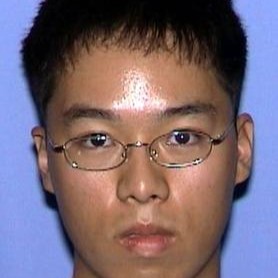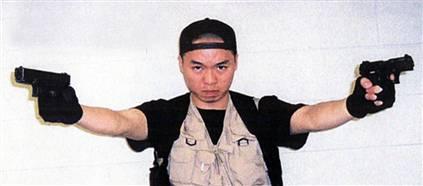
1984 - 2007
Cho Seung-hui
Summary
Name:
Cho Seung-huiYears Active:
2007Birth:
January 18, 1984Status:
DeceasedClass:
Mass MurdererVictims:
32Method:
ShootingDeath:
April 16, 2007Nationality:
South Korea
1984 - 2007
Cho Seung-hui
Summary: Mass Murderer
Name:
Cho Seung-huiStatus:
DeceasedVictims:
32Method:
ShootingNationality:
South KoreaBirth:
January 18, 1984Death:
April 16, 2007Years Active:
2007bio
Cho Seung-hui was born on January 18, 1984, in the city of Asan, South Korea. He lived in a basement apartment in Seoul for a few years. His father owned a bookstore but struggled to make a profit. In 1992, when Cho was eight years old, his family immigrated to the United States seeking better education and opportunities. They first settled in Detroit before moving to Centreville, Virginia, where they discovered a large South Korean community.
In Centreville, Cho's parents opened a dry-cleaning business. The family became permanent residents of the U.S., and his parents became active members of a local Christian church. Cho grew up in this religious environment, but he later expressed conflict with his parents' strong Christian beliefs.
During his early childhood, family members in South Korea raised concerns about Cho's behavior. They noted that he rarely spoke and seemed to lack affection. His grandfather mentioned that Cho never made eye contact or showed warmth towards him, which worried the family.
Cho attended Poplar Tree Elementary School in Fairfax County. When he first arrived in the U.S., he often cried and had tantrums about going to school. Despite this, he was able to finish the elementary program in an unusually short time and was considered a good student by his teachers.
He later went to Ormond Stone Middle School and then Westfield High School. By eighth grade, Cho was diagnosed with selective mutism, which made it difficult for him to speak in certain situations. He experienced bullying throughout high school, often due to his shyness and mannerisms. Many classmates described him as a loner who avoided social interactions.
While in ninth grade, Cho became deeply affected by the Columbine High School massacre. He admired the shooters and wrote about wanting to imitate their actions. This led to his family being informed, and he was subsequently referred to a psychiatrist.
Throughout his education, Cho continued to struggle with his mental health. His selective mutism diagnosis led to therapy and special education services. He was identified as having emotional disturbances and received accommodations in school, such as being excused from oral presentations.
As he transitioned to Virginia Tech in 2003, Cho initially majored in business information technology but later switched to English, aspiring to be a writer. His behavior remained concerning, and teachers noticed his unsettling writings and interactions in class. He was involved in a few troubling incidents, including being accused of stalking female students, which raised alarm among campus officials.
Despite several attempts by his family and school professionals to seek help for his mental health issues, Cho's situation continued to deteriorate throughout his college years. He experienced isolation, strange behavior, and mental health challenges without adequate treatment or follow-up from authorities.
murder story
Around 7:15 a.m. on April 16, 2007, Cho Seung-hui killed two students, Emily J. Hilscher and Ryan C. "Stack" Clark, at the West Ambler Johnston Hall dormitory at Virginia Tech. After this initial attack, he returned to his dormitory room to gather more weapons. During this time, he mailed a package to NBC News containing a video and written materials.
At approximately 9:45 a.m., Cho walked to Norris Hall, where he began shooting. In a span of about nine minutes, he shot many people, resulting in the deaths of 30 individuals. As police entered Norris Hall to confront him, Cho took his own life with a gunshot to the head.

After the attacks, gun analysis confirmed that the same gun was used in both locations. Investigators found that Cho fired over 170 rounds throughout the incidents. Evidence showed that he had practiced shooting at a range prior to the attacks, and he had legally acquired his firearms despite a court order for mental health treatment, which he did not follow. The police later confirmed his identity through evidence left at the crime scenes.